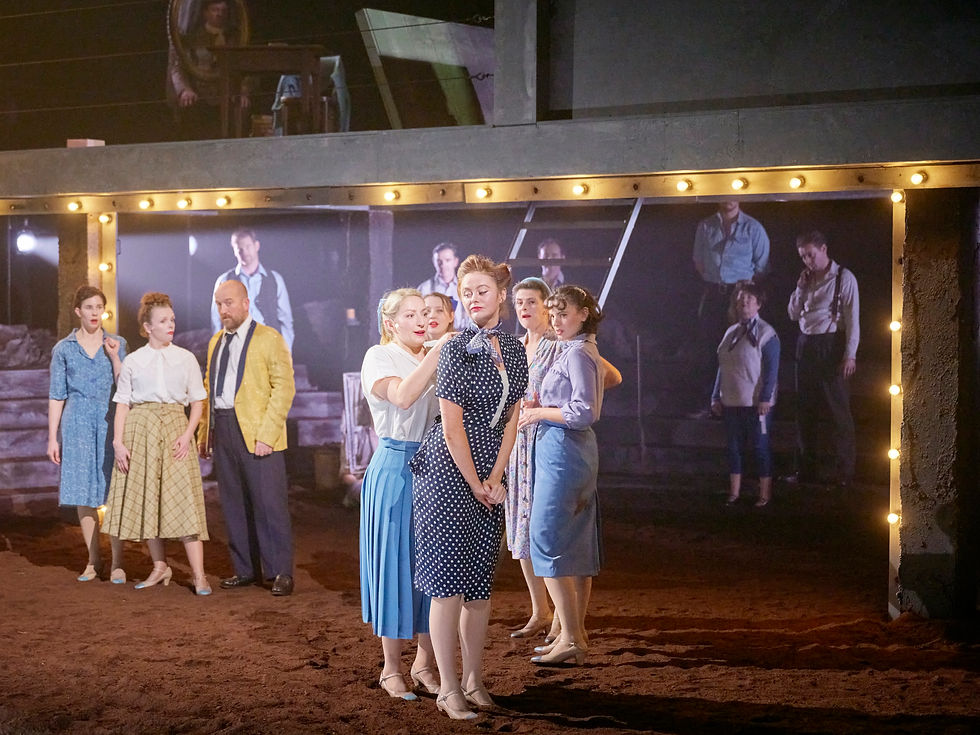Dublin Gothic
- Chris O'Rourke
- Nov 28
- 4 min read
Updated: Nov 30

Dublin Gothic by Barbara Bergin. Image, Ros Kavanagh
***
It’s often claimed texting is responsible for the demise of good writing. Resorting to acronyms, emojis and words without vowels. Which still doesn't account for the upturn in problematic playwriting. Take Barbara Bergin's Dublin Gothic. An ambitious, three and half hour, award nominated litany of trun out details. Its tone suggesting an official reading of Anecdotal Records from a Tenement Life Report, circa 1830 to 1982, complete with encyclopaedic glossary. Begging the question, WT actual F? By which we mean what’s the actual finances being spent here? Back to back big budget, big cast, durational offerings at The Abbey suggesting investment in the semi-dark Peacock might have better served the development of new writing. Mind you, given recent works like The Revenger’s Tragedy, some might prefer for The Peacock to remain dark.

Sarah Morris, Erika Roe, Thommas Kane Byrne and Emmet Farrell in Dublin Gothic by Barbara Bergin. Image, Ros Kavanagh
In a nutshell, Bergin’s generational love letter to Dublin doesn’t deliver what it says on the tin. Being less a play so much as a distressed novel looking for excitement by masquerading as story telling theatre. One where everything is told and little is shown as we follow a series of wronged women residing at the same address over several troubled decades. Proverbial mothers, virgins and whores given vivid life by the incomparable Sarah Morris. Nor is Dublin Gothic an epic, despite a truncated Greek chorus and efforts to cram a century and a half of information down the audience’s throat. It’s not even a series of stories so much as a same old story. That of a put upon woman and waster man and the impact on their children over generations. Except the women are not the real voices. Though they’ve endless walk on parts, there’s only one central character and that's Bergin. No matter who's talking, the author’s narrating voice is all we truly hear. Building a limiting picture from reportage details punching above their literary weight. Text, like its use of language based comedy, landing an occasional good line, captive phrase or fleeting insight. Mostly it lacks rhythm and timing, ensuring relentlessly flailing punches frequently miss their mark as we jump from the 1830s to the 1910s, the 1950s to the early 1980s in a dull blur of details.

Áine Ní Laoghaire, Denise McCormack, Gus McDonagh, Sarah Morris, Roxanna Nic Liam, Kate Gilmore, Clara Fitzgerald and Penny Morris in Dublin Gothic by Barbara Bergin. Image, Ros Kavanagh
Most significantly, this is not Dublin but a mirrored, multi-verse, fictionalised alternative. A game of spot the reference; Brendan Behan, Matt Talbot and Father Michael Cleary to name but a few. A Dublin minus its core, where the untidy threads of one family’s history highlight poverty, emigration, Catholicism, landlords, sex work, AIDs, the patriarchy, add your own. A veneer of social history at which you don’t dare blink less you miss another heavy handed detail flying past. Abortion, crude sex, and women abandoned by lustful men establishing a narrative baseline for three and a half hours. In fairness, it never feels it.

Clara Fitzgerald, Kenneth Hudson, Joshua McEneaney, Roxanna Nic Liam, Sarah Morris and Emmet Farrell in Dublin Gothic by Barbara Bergin. Image, Ros Kavanagh
Issues don't lie entirely with Bergin. Director Caroline Byrne’s staging is rarely deeper than deftly moving bodies from place to place. Byrne shining a wide social floodlight, rather than an emotionally deep spotlight, leaving the whole hurried and hollowed out, with blurred characters reduced to rough sketches on Jamie Vartan’s imposing set. Its skeletal interior of a haunted tenement frame sees a cellar evoke an archaeological and theatrical past. The whole resembling pop art, comic book panels, each competing for attention rather than leading the eye. Madeline Boyd’s costumes reinforcing clichés whilst Aédin Cosgrove’s lights look so dim they suggest they're trying to keep the electricity bill down. Giles Thomas’s cinematic compositions arriving quietly, like they’re embarrassed and not entirely comfortable being there, evident in painful attempts at half baked songs. Meanwhile a superlative cast confirm the well-known truism: strong performances cannot elevate a weak play. Karen Ardiff, Jonathan Delaney Tynan, Carolyn Donnelly, Seán Duggan, Emmet Farrell, Clara FitzGerald, Kate Gilmore, Kenneth Hudson, Thommas Kane Byrne, Barry John Kinsella, Denise McCormack, Gus McDonagh, Joshua McEneaney, Dan Monaghan, Penny Morris, Roxanna Nic Liam, Áine Ní Laoghaire and Ericka Roe giving life to the one hundred character scraps thrown to them. Monaghan, McDonagh, Gilmore, Kane Byrne, Ardiff, Kinsella, Ni Laoghaire and the dream duo of Roe and Sarah Morris standing out in an invested ensemble.

Dublin Gothic by Barbara Bergin. Image, Ros Kavanagh
Nostalgically sentimental once the house lights decline, this is Dublin City built from rare old times. Delivering a salacious page turner more Jackie Collins than Michael Collins. Fifteen years in the making, Bergin’s ghostly aspirations are true and sincere, with Dublin Gothic a dynamo of energy and aspiration. Yet thematically dwarfed by Ulysses and Strumpet City, theatrically Dublin Gothic is dwarfed by the ghost of O’Casey and the spirit of ANU. A company who have definitively chronicled invisible histories, frequently of women, from Dublin’s rich and varied past over the past decade. Next to which Dublin Gothic looks redundant, having too much to say and too little to offer. As memory, history and culture, Dublin Gothic is a well intentioned conflict of medium and message. It’s said a play might be good, but not good enough to be an Abbey play. Begging, yet again, the question, wt actual f? One wonders if rethinking such standards might not be overdue.
Dublin Gothic by Barbara Bergin, runs at The Abbey Theatre until January 31st, 2026.
For more information visit The Abbey Theatre





















